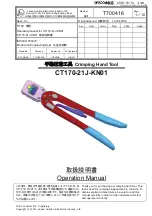
6
GB
the power tool. If damaged, have the power tool
repaired before use. Accidents are caused by
poorly maintained power tools.
f. Keep cutting tools sharp and clean. Properly
maintained cutting tools with sharp cutting
edges are less likely to bind and are easier to
control.
g. Use the power tool, accessories and tool bits in
accordance with these instructions and in the
manner intended for the particular type of power
tool, taking into account the working conditions
and the work to be performed. Failure to use
the tool for its intended purposes could result
in a hazardous situation and may invalidate the
warranty.
5. SERVICE
a. Have your power tool serviced by a qualified
repair technician, using only identical
replacement parts. This will ensure that the
safety of the power tool is maintained.
NOTE:
The tool must be used only for its prescribed
purpose. Any use other than those mentioned in
this manual will be considered a case of misuse.
The user and not the manufacturer shall be liable
for any damage or injury resulting from such
cases of misuse. To use this tool properly observe
the safety regulations, assembly instructions
and operating instructions, which can be found
in this manual. All persons who use and service
the machine must be informed about its potential
hazards and be acquainted with this Manual.
Children and frail people must not use this tool.
Children should be supervised at all times if they
are in the area in which the tool is being used. It
is also imperative that you observe the accident
prevention regulations in force in your area. The
same applies for general rules of occupational
health and safety. The manufacturer shall not be
liable for any changes made to the tool nor for any
damage resulting from such changes. Even when
the tool is used as prescribed it is not possible to
eliminate all residual risk factors.
Safety Instructions / Assembly
ASSEMBLY
ASSEMBLING THE TABLE & RIP FENCE
STEP 1
Using the fasteners from Fastener Bag 1, insert 6
Flange Nuts (10) into each Long Extrusion (1) as
shown in Inset 1, (Fig. 1).
Lay out the two long extrusions and the two short
extrusions as shown in (Fig. 1), making sure that all
of the flange nuts are facing inwards.
Plug the corner blocks of the Short Extrusions (2)
into the ends of the long extrusions and tap fully
home with a mallet (or similar).
STEP 2
Turn the table over (face down, as in Fig. 2) on a
flat surface and loosely attach the Corner Brackets
(5), using the Hex Bolts (11) and Washers (13) into
the flange nuts. (Slide the flange nuts into position
using a screwdriver).
Ensure that the two printed corner brackets are
bolted with their correct edges on the same long
extrusion (Fig. 1).
Loosely fit the Brace Brackets (9) to the Braces (4)
using Hex Bolts (11), Washers (13) and Hex Nuts
(12). See Inset 2 (Fig 1).
Position the braces about 315mm in from each side
of the frame (Fig. 2) and loosely attach the braces
with hex bolts and washers into the remaining
flange nuts. Do not tighten any of the fasteners yet.
There should be two flange nuts left over. These
can be used later for fitting jigs etc (Fig. 9).
STEP 3
Turn the table face upwards and insert the Scales
(3) between the long extrusions and the brace and
corner brackets. Position them with the 380mm
ends hard up against the short extrusion on the
'map of Australia' side of the table. Push the scales
down until they 'click' into position, flush with the
top face of the long extrusions, as shown in Inset 3
on (Fig. 1).
Turn the table over (face down). Make sure the
corner brackets are pushed fully home into the
corners, and the plastic corner blocks are still fully
inserted into the ends of the extrusions.
Tighten the 8 bolts holding the corner brackets. Do
not over-tighten. (Tighten each pair of bolts a little
at a time, to ensure you don’t distort the frame).
Next tighten the 8 bolts holding the brace brackets
to the long extrusions, and finally tighten the 4
bolts through the braces.






























